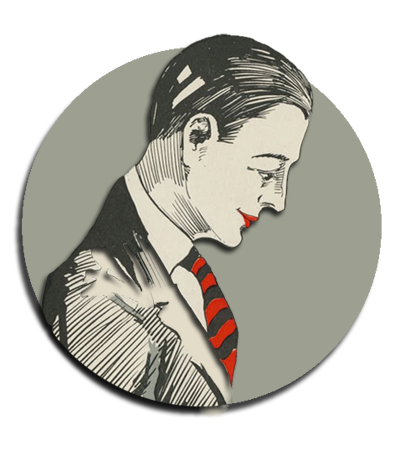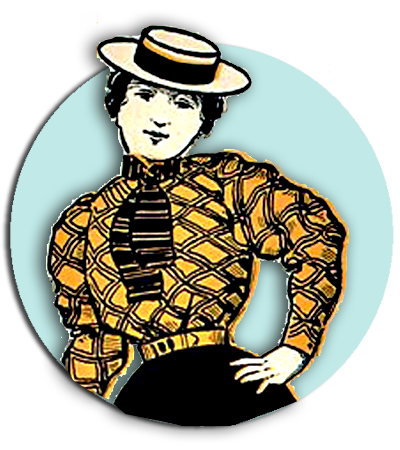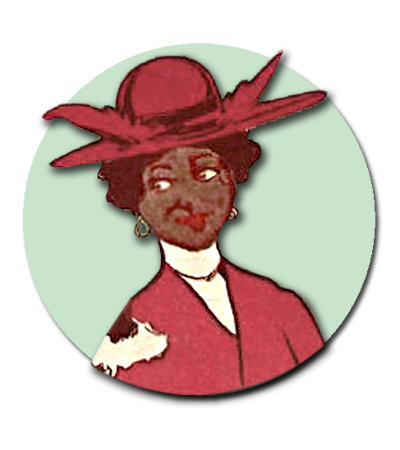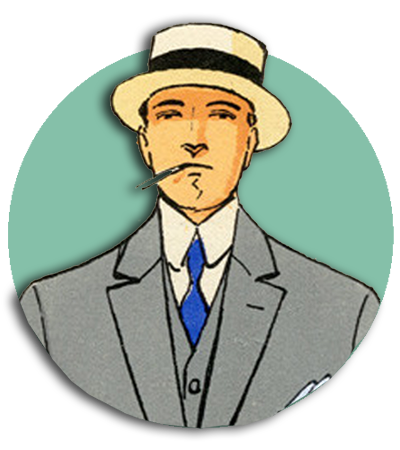If you toured Chicago in 1910, what would you do?
Would you bask in opulence at Marshall Field’s? Venture to the city’s first African-American theater? Seek illicit thrills at the Levee? Experience the city through the eyes of last century’s tourists!

Julian Street:
The Travel Writer
You are Julian Street, a New York journalist stopping in Chicago on a 5,000-mile tour across America for a travel book you’re writing. Expenses aren’t a big concern for you — since the publisher’s paying your bills! You were born in Chicago, but you’ve been away for years. (Note: This character is real, and the following postcards feature quotations from Street’s 1914 book Abroad at Home, edited for length.)

Jane Wilson:
The Farm Girl
You are Jane Wilson, a farmer’s daughter from Waterloo, Iowa. You’ve read about Chicago in books and magazine articles and want to see the opulence of the city for yourself. Your money’s tight, though, so you went looking for a bargain. The 300-mile trip normally costs $17, but you planned ahead for the $3 weekend ticket. (The ticket cost $75 in today’s dollars).

Emma Parks:
The Schoolteacher
You are Emma Parks, an African-American schoolteacher from Natchez, Mississippi. You’ve read about Chicago in Defender articles — Pullman porters are carrying the newspaper south with them — and you’re eager to see if this big northern city offers more culture and freedom than your hometown. If you see job opportunities for a young black woman in “Chi” (as the Chicago Defender often calls this city), you may decide to move here for good.

Joe Schroeder:
The Thrill Seeker
You are Joe Schroeder, a 23-year-old department store clerk from Toledo, Ohio. You’ve got a bit more cash than usual — your winnings from a lucky wager on a horse race — and you’re looking for a hot time. You’ve heard whispers from other men that Chicago’s the place to go for some illicit thrills.
![picture of COPY.julian-street.0.name [column does not exist in sheet]](https://s3.amazonaws.com/wbez-assets/curiouscity/1910/julian-street.png)
![picture of COPY.julian-street.0.name [column does not exist in sheet]](https://s3.amazonaws.com/wbez-assets/curiouscity/1910/julian-street.png)
Further, the Blackstone occupies a position, with regard to the fashionable life of Chicago, which is not paralleled by any single hotel in New York. Socially it is preeminently the place.”
— Julian Street, 1914
![picture of COPY.julian-street.1.name [column does not exist in sheet]](https://s3.amazonaws.com/wbez-assets/curiouscity/1910/julian-street.png)
![picture of COPY.julian-street.1.name [column does not exist in sheet]](https://s3.amazonaws.com/wbez-assets/curiouscity/1910/julian-street.png)
The Art Institute has not the deserted look of most other art museums one visits. It is used. This may be partly accounted for by its admirable location at the center of the city — a location more accessible than that of any other museum I think of, in the country. But whatever the reason, as you watch the crowds, you realize more than ever that Chicago is alive to everything — even to art.”
— Julian Street, 1914
![picture of COPY.julian-street.2.name [column does not exist in sheet]](https://s3.amazonaws.com/wbez-assets/curiouscity/1910/julian-street.png)
![picture of COPY.julian-street.2.name [column does not exist in sheet]](https://s3.amazonaws.com/wbez-assets/curiouscity/1910/julian-street.png)
The manners of the pigs on their way to execution held me with a horrid fascination. I had never before suspected that all pigs are so very much like people. Some of them come in yelling with fright. Others are silent. They shift about nervously, and sniff, as though scenting death. ‘It's the steam they smell,’ said a man in overalls beside me. Well, perhaps it is. But I could smell death there, and I still think the pigs can smell it, too.”
— Julian Street, 1914
![picture of COPY.julian-street.3.name [column does not exist in sheet]](https://s3.amazonaws.com/wbez-assets/curiouscity/1910/julian-street.png)
![picture of COPY.julian-street.3.name [column does not exist in sheet]](https://s3.amazonaws.com/wbez-assets/curiouscity/1910/julian-street.png)
Another thing which interested me in Field's was the appearance of the saleswomen. They do not look like New York saleswomen. In the aggregate they look happier, simpler, and more natural. I saw no women behind the counters there who had the haughty, indifferent bearing, the nose-in-the-air, to which the New York shopper is accustomed. Among these women, no less than among the rich, the Chicago spirit seemed to show itself. It is everywhere, that spirit.”
— Julian Street, 1914
![picture of COPY.julian-street.4.name [column does not exist in sheet]](https://s3.amazonaws.com/wbez-assets/curiouscity/1910/julian-street.png)
![picture of COPY.julian-street.4.name [column does not exist in sheet]](https://s3.amazonaws.com/wbez-assets/curiouscity/1910/julian-street.png)
‘I’ll tell you a funny thing about this place,’ said my friend the veteran police reporter. ‘No one has ever been killed in here,’ he said. I had to admit that it was a funny thing. After looking at the faces lined up at the bar I should not have imagined it possible.
Presently we crossed the street to the Alderman's other saloon. Here we met Hinky Dink. He is a slight man. He wore an extremely neat brown suit, a round black felt hat, and a heavy watch chain, from which hung a large circular charm with a star and crescent set in diamonds. He looked as if he had just been washed and brushed. The little Alderman is very quiet. There is, indeed, a kind of gentleness about him.”
— Julian Street, 1914
![picture of COPY.jane-wilson.0.name [column does not exist in sheet]](https://s3.amazonaws.com/wbez-assets/curiouscity/1910/jane-wilson.png)
![picture of COPY.jane-wilson.0.name [column does not exist in sheet]](https://s3.amazonaws.com/wbez-assets/curiouscity/1910/jane-wilson.png)
Dear Ma and Pa,
Lake Michigan is so big. This is just how I imagine the oceans must look. The lines of the city streets stretch on and on, almost as far as the eye can see — out toward the prairies. But there’s so much smoke in the air, I had trouble seeing some of the skyscrapers.
— Jane
“A bird’s-eye view from this eminence reveals some strange and interesting things. Michigan boulevard appears like a long, white tape or thread, with its thousands of vehicles and pedestrians. … And last, but not least, is the view by night. The myriads of lights of every description all over the city, in every direction as far as the eye and glass can reach, scattered and in clusters, and in long double rows, threading either side of the streets and avenues, are a charming and fascinating sight that reminds you of the fables of the Arabian Nights and Aladdin’s Cave. Then add the moonlight, and the enchantment is complete.”
— Moran’s Dictionary of Chicago and Its Vicinity” (1910)
![picture of COPY.jane-wilson.1.name [column does not exist in sheet]](https://s3.amazonaws.com/wbez-assets/curiouscity/1910/jane-wilson.png)
![picture of COPY.jane-wilson.1.name [column does not exist in sheet]](https://s3.amazonaws.com/wbez-assets/curiouscity/1910/jane-wilson.png)
It’s like walking through a forest or a jungle. Some of the rooms are so steamy! And the plants are so marvelous, peculiar things we’ve never seen in Iowa. I wondered how they’d built this greenhouse around the lagoons and waterfalls, but one of the men told me these weren’t natural — they were constructed, too. Imagine that!
Jane
“The beauty and loveliness that I beheld proved a feast fit for the gods themselves. … Flowers and foliage plants … are there from Madagascar, from Australia, from Japan, from the South Sea Islands, from the faraway frozen north — from everywhere. … One of the more enticing charms of the fernery is the smell of the virgin woods, carrying us back to childhood days when we wandered in the forest beside the rippling brook or river, and loved the ferns and honeysuckles which sprang from the niches in the steep banks and rocky bluffs. Here are the cascades, and we hear the musical tinkle of the water, failing and flowing, that was loved so much in the woodland in the days long ago.” — Tribune writer Ewing Love, 1910
![picture of COPY.jane-wilson.2.name [column does not exist in sheet]](https://s3.amazonaws.com/wbez-assets/curiouscity/1910/jane-wilson.png)
![picture of COPY.jane-wilson.2.name [column does not exist in sheet]](https://s3.amazonaws.com/wbez-assets/curiouscity/1910/jane-wilson.png)
Lake Shore Drive was one of the prettiest rides I’ve ever taken. But dear me! Our chauffeur seemed rather untrustworthy. I was so alarmed by his wild motoring that I decided to exit the vehicle at Lincoln Park. Luckily, a streetcar took me back downtown.
Jane
“The Lake Shore Drive is one of the show places of the city. … The drive skirts the Lake Front, and is lined on the left with some of the most beautiful residences in the city. On the right is a shaded bridle path and beyond a gently sloping beach, faced with great blocks of granite, as a protection from the storm waves which at times beat down with terrible force.” — Chicago Association of Commerce Guidebook, 1909
![picture of COPY.jane-wilson.3.name [column does not exist in sheet]](https://s3.amazonaws.com/wbez-assets/curiouscity/1910/jane-wilson.png)
![picture of COPY.jane-wilson.3.name [column does not exist in sheet]](https://s3.amazonaws.com/wbez-assets/curiouscity/1910/jane-wilson.png)
I had such a nice time dining at Henrici’s with Minnie, my old friend from Cedar Falls. I had the roast Long Island duck with dressing, baked apple and candied sweet potatoes. Delicious! I think those fellows sitting at the table next to us were aldermen. Don’t worry — we avoided speaking with them.
Jane
“Many a time, at luncheon, a leading personality in civic government, in finance, or in commercial or professional life, will be found seated at the same table with a stranger from a very modest walk in life. This is Henrici’s.” — Henrici’s ad, Chicago Tribune, 1918
“Henrici’s has never been influenced by the craze for over-decoration and other bizarre effects elsewhere deployed. When music in various forms was first highly favored as a restaurant attraction Henrici’s advertised ‘no music.’ The phrase ‘no orchestral din’ has since become familiar to most of the residents of Chicago.” — Henrici’s ad, Chicago Inter Ocean, 1914
“Any acquaintance in Chicago will tell you Henrici’s is by all odds the place to dine. Appropriate for ladies. A famous restaurant moderate in its charges.” — Henrici’s ad, Janesville Daily Gazette, 1914
![picture of COPY.jane-wilson.4.name [column does not exist in sheet]](https://s3.amazonaws.com/wbez-assets/curiouscity/1910/jane-wilson.png)
![picture of COPY.jane-wilson.4.name [column does not exist in sheet]](https://s3.amazonaws.com/wbez-assets/curiouscity/1910/jane-wilson.png)
I’ve never heard such beautiful music in all my life. I couldn’t help crying when the chorus sang ‘Ode to Joy.’
Jane
“The stage, toward which all of them are bent like flowers to the light, seems to be miles away, and is set out in formal rows of black clothed men intent on making music. For the high audience nothing exists except that distant spot, their own gallery, and the unmitigated void between. A little flaxen haired, white faced boy gets so excited that he jumps out of his seat. … An old, white haired man is over in an obscure corner. He leans his wrinkled cheek on the creamy horn handle of his cane, and he might be happily dreaming as his thin nostrils and veined eyelids twitch.” — Tribune reporter Mary Isabel Brush, describing Orchestra Hall’s uppermost level, 1910
“The audience … voiced its approval most emphatically. … When the first great theme was announced … it burst forth like a mighty challenge from chorus which assembled all the voices of the human heart that tell of sorrow and of struggle.” — Glenn Dillard Gunn’s Chicago Tribune review of Beethoven’s Ninth Symphony, 1910
![picture of COPY.emma-parks.0.name [column does not exist in sheet]](https://s3.amazonaws.com/wbez-assets/curiouscity/1910/emma-parks.png)
![picture of COPY.emma-parks.0.name [column does not exist in sheet]](https://s3.amazonaws.com/wbez-assets/curiouscity/1910/emma-parks.png)
Oh, how marvelous it was to see a show at the Pekin last night! I never thought I’d see colored people given the opportunity to perform with such dignity on the stage.
Emma
“I have never felt so proud of being a colored man. … The entertainment was a revolution and shows just what Negroes can and must do in the near future.” — Vaudeville star Sherman Dudley, after visiting the Pekin, 1906
“The race owes Mr. Mott a debt of gratitude for giving us a theater in which we could sit anywhere we chose without any restrictions.” — Ida B. Wells-Barnett, anti-lynching crusader, 1906
“The audiences at the Pekin theater, so far as I could judge, are made up of the better class of colored people — men with their wives and families out for an evening’s enjoyment. There is a very liberal sprinkling of white people who have heard of this curious little theater, and who, if the truth were known, come to leer, but who remain to split their sides with laughter and their gloves with honest applause.” — Chicago Inter Ocean reporter Dan Riley, 1905
![picture of COPY.emma-parks.1.name [column does not exist in sheet]](https://s3.amazonaws.com/wbez-assets/curiouscity/1910/emma-parks.png)
![picture of COPY.emma-parks.1.name [column does not exist in sheet]](https://s3.amazonaws.com/wbez-assets/curiouscity/1910/emma-parks.png)
Everywhere I went on State Street last night, people were singing that tune “Some of These Days,” and now it’s stuck in my head. Some folks warned me that “The Stroll” is rather rowdy and risqué, but I had a perfect gentleman as an escort, and we encountered no trouble.
Emma
“Everything is ablaze … This continuous street fair has taken a hold on the people the same as a seaside resort. You haven’t been out if you haven’t taken a stroll from Twenty-seventh street as far up as Thirty-fifth street.” — Chicagoan Will Foster, 1908
“South State Street was in its glory then, a teeming Negro street with crowded theaters, restaurants, and cabarets. And excitement from noon to noon. Midnight was like day. The street was full of workers and gamblers, prostitutes and pimps, church folks and sinners.” — Poet Langston Hughes, on his visit, 1918
![picture of COPY.emma-parks.2.name [column does not exist in sheet]](https://s3.amazonaws.com/wbez-assets/curiouscity/1910/emma-parks.png)
![picture of COPY.emma-parks.2.name [column does not exist in sheet]](https://s3.amazonaws.com/wbez-assets/curiouscity/1910/emma-parks.png)
You told me so many times how you worked at that amazing World’s Fair in ‘93. Well, now I’ve seen the place, but I doubt if you’d recognize it. The park is lovely, however.
Emma
“Jackson Park is unsurpassed anywhere for beauty, having the advantages of ample space, the blue waters of Lake Michigan for a foreground, a natural growth of trees and the aid of the best landscape gardeners’ art to bring all into harmony. … Those who came to Chicago in 1893 will always associate this park with the surpassingly beautiful group of buildings which were a part of the World’s Columbian Exposition.” — Chicago Association of Commerce Guidebook, 1909
![picture of COPY.emma-parks.3.name [column does not exist in sheet]](https://s3.amazonaws.com/wbez-assets/curiouscity/1910/emma-parks.png)
![picture of COPY.emma-parks.3.name [column does not exist in sheet]](https://s3.amazonaws.com/wbez-assets/curiouscity/1910/emma-parks.png)
I’ve taught children in Natchez about the beasts in Africa and prehistoric monsters, but it was astonishing to see them in front of me. Thank heavens they were stuffed!
Emma
“To scientists and special students, … the Museum is an inexhaustible mine but any visitor to Chicago may spend at least a day here with pleasure.” — Chicago Association of Commerce Guidebook, 1909
“There’s a man that is tickled because he is not a monkey, but a man. I don’t blame him; I am myself. I am myself. I went out to see the ‘orang-outang’ at the Field Museum. There he was. Did you notice those long, lean, hairy, mighty fingers? That is a sign he is monkey. He couldn’t play the piano. He couldn’t read Shakespeare’s tragedies. He is a beast. And this hand is a sign we are not beasts but folks.” — The Rev. William Quayle of St. James Methodist Episcopal Church in Chicago, 1906
![picture of COPY.emma-parks.4.name [column does not exist in sheet]](https://s3.amazonaws.com/wbez-assets/curiouscity/1910/emma-parks.png)
![picture of COPY.emma-parks.4.name [column does not exist in sheet]](https://s3.amazonaws.com/wbez-assets/curiouscity/1910/emma-parks.png)
I am only beginning to understand the rules of base-ball, but I must say it was quite a spectacle, the way those Giants knocked and threw that little white ball back and forth across the field. The spectators got rather excited, and I cheered along with them.
Emma
“Don’t forget that the Leland Giants’ Park … is the only park in the city owned and controlled by our people, and that if you stand for anything and want to see a good ball game you will go there. Enough said.” — Chicago Defender, 1910
“Colored Team Is the Best. While undoubtedly it is galling to many persons to see a colored nine take honors from five white teams, the Leland Giants are entitled to a place in the (Chicago semi-pro) league by their drawing powers, for the public … demands their presence. The colored men played the best ball, were entitled to win, received a fair deal from unprejudiced umpires, and did win.” — Chicago Tribune, 1909
![picture of COPY.joe-schroeder.0.name [column does not exist in sheet]](https://s3.amazonaws.com/wbez-assets/curiouscity/1910/joe-schroeder.png)
![picture of COPY.joe-schroeder.0.name [column does not exist in sheet]](https://s3.amazonaws.com/wbez-assets/curiouscity/1910/joe-schroeder.png)
I couldn’t make heads or tails of what was going on in ‘The Pit,’ but those fellows certainly seemed to be excited about something. I think I’ll stick with playing the ponies!
Your pal,
Joe
“The din and confusion, especially when prices are rapidly fluctuating, are indescribable and to the average onlooker all is meaningless when as a matter of fact a regular system and orderly procedure is back of all the seeming chaos.” — Chicago Association of Commerce Guidebook, 1909
“Arms were flung upward in strenuous gestures, and from above the crowding heads in the Wheat Pit a multitude of hands, eager, the fingers extended, leaped into the air. All articulate expression was lost in the single explosion of sound as the traders surged downwards to the centre of the Pit, grabbing each other, struggling towards each other, tramping, stamping, charging through with might and main.” — Frank Norris in his novel The Pit, 1903
![picture of COPY.joe-schroeder.1.name [column does not exist in sheet]](https://s3.amazonaws.com/wbez-assets/curiouscity/1910/joe-schroeder.png)
![picture of COPY.joe-schroeder.1.name [column does not exist in sheet]](https://s3.amazonaws.com/wbez-assets/curiouscity/1910/joe-schroeder.png)
Well, I tried chop suey. It just might be the most peculiar thing I’ve ever tasted, but I wouldn’t mind having it again sometime. This Chinese restaurant was a real high-class joint. I didn’t expect that!
Your pal,
Joe
“No city outside of San Francisco has such a number of Chinese restaurants. Many of them are excellent.” — Onward, a Universalist Church magazine, in 1910
“Tea and grocery shops, laundries, and opium and gambling dens line this thoroughfare. … On many of the second floors are Chinese restaurants, some richly furnished with costly tables, chairs, and settees, inlaid with ivory and marble, and having gilded walls and ceilings and luxurious hangings and decorations. These places are mainly patronized by white people, and keep open till long after midnight.” — Journalist William Salisbury, describing Clark Street in a 1908 book
![picture of COPY.joe-schroeder.2.name [column does not exist in sheet]](https://s3.amazonaws.com/wbez-assets/curiouscity/1910/joe-schroeder.png)
![picture of COPY.joe-schroeder.2.name [column does not exist in sheet]](https://s3.amazonaws.com/wbez-assets/curiouscity/1910/joe-schroeder.png)
Compared with our store in Toledo, this place was a disorganized mess. But I did find a sporty-looking cap and haggled the price down to 25 cents. What a find!
Joe
“The Ghetto Market is in a class by itself. It is one of the interesting sights of Chicago and will be enjoyed by the average visitor looking for the unusual, though it is squalid and dirty to a degree.” — Chicago Association of Commerce Guidebook, 1909
“A busy bee-hive, crowded with men and women in search of bargains in all kinds of merchandise from a silk tails to ‘frische Fisch.’ Jefferson street became one of the sights of Chicago and visitors often came there to see the ‘Jewish market,’ as they go in New Orleans to see the ‘French Market.’” — The Advocate: America's Jewish Journal, 1911
![picture of COPY.joe-schroeder.3.name [column does not exist in sheet]](https://s3.amazonaws.com/wbez-assets/curiouscity/1910/joe-schroeder.png)
![picture of COPY.joe-schroeder.3.name [column does not exist in sheet]](https://s3.amazonaws.com/wbez-assets/curiouscity/1910/joe-schroeder.png)
My stomach ain’t feeling so good after taking a spin on some of those rides. But you should’ve seen the costumes some of the girls on the boardwalk were wearing — wow! I had a pretty swell time.
Joe
“At night the great mass of joy-seeking humanity rolled up and down the boardwalk like the resistless tide of the sea, the ballyhoos ballyhooed, and the bands played, and singers sang, and waiters waited, and all was mirth and happiness everywhere.” — Chicago Tribune writer Richard Henry Little, 1911
“The admission of children of tender age, the suggestive and indecent talk of the barkers is a disgrace, and the performance itself is vile, vulgar, and vicious. We ask that the performers be made to wear more clothing and observe at least a semblance of decency.” — A committee of preachers, 1909
![picture of COPY.joe-schroeder.4.name [column does not exist in sheet]](https://s3.amazonaws.com/wbez-assets/curiouscity/1910/joe-schroeder.png)
![picture of COPY.joe-schroeder.4.name [column does not exist in sheet]](https://s3.amazonaws.com/wbez-assets/curiouscity/1910/joe-schroeder.png)
Don’t tell anyone, but I got into a spot of trouble last night. I went looking for that Everleigh place we heard about, but ended up in some low-class resort. I don’t remember much — I woke up in an alley with a lump on my head and all of my money gone. I’m glad I already bought my train ticket home.
Joe
”“The ‘levee,’ blazing with electric lights and floating in liquor, is regarded by thousands of visitors as one of the chief sights of Chicago.” — Anti-prostitution crusader Ernest A. Bell, 1910
“Noise blared from the pianos. The red lights gleamed. Men, young and middle-aged, reeled from saloon to bawdyhouse. Girls led their customers from the dance halls to the ever ready hotels.” — Charles Washburn, a Chicago journalist writing about the time, 1934
“The inmates sit behind curtained windows and as men approach the houses they tap on the window panes. Lookouts are stationed near the windows and in front of saloons and warn the solicitors when the officer on the beat approaches.” — report by the Vice Commission of Chicago, 1911
 This Curious City presentation was inspired by a question asked by from John Gardiner IV, a research associate at a small biotech firm in Seattle. An avid train buff, Gardiner has an H.O. model train set in his home and he attends a model railroad club’s weekly meetings at the train depot in Edmonds, Washington. That’s where he sees Amtrak’s Empire Builder train making its journey from Seattle to Chicago — a sight that inspired him to begin planning his own train ride to Chicago this summer. He had visited Chicago once before, when he was about 11. He says he remembers the Sears Tower and Gino’s East pizza.
This Curious City presentation was inspired by a question asked by from John Gardiner IV, a research associate at a small biotech firm in Seattle. An avid train buff, Gardiner has an H.O. model train set in his home and he attends a model railroad club’s weekly meetings at the train depot in Edmonds, Washington. That’s where he sees Amtrak’s Empire Builder train making its journey from Seattle to Chicago — a sight that inspired him to begin planning his own train ride to Chicago this summer. He had visited Chicago once before, when he was about 11. He says he remembers the Sears Tower and Gino’s East pizza.
Credits:
Reporting by Robert Loerzel | Production & Art Direction by Logan Jaffe | Editing by Shawn Allee | Audio story production & editing by Jesse Dukes | Additional web production by Chris Hagan
Listen to the audio version of this story:
Postcard scans courtesy of Chuckman's Collection and Robert Loerzel, images courtesy Chicago History Museum and the Library of Congress.
To learn more about the tourist attractions of Chicago in 1910, read some of the books we used in our research:
A Guide to the City of Chicago by the Chicago Association of Commerce (1909)
Moran's Dictionary of Chicago and Its Vicinity: An Alphabetically Arranged Dictionary, Comprising All of the Interests that Contribute to Chicago's Greatness (1910)
Karl Baedeker’s 1909 travel guide to the United States — see Page 366 for the section about Chicago.
Abroad at Home by Julian Street (1914)